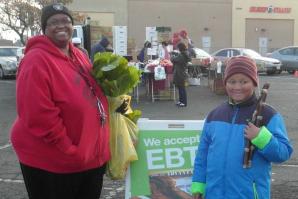
Sacramento chefs like to think backwards. When it comes to menus, they let the ingredients dictate the dish — not the other way around.
At least that’s the case with Mulvaney’s B&L owner and chef Patrick Mulvaney, who has cooked with products almost exclusively from regional California farmers and ranchers for more than 20 years.
The result: An ever-changing seasonal menu that is as brief as the kale is healthy.
The Sacramento region is at the forefront of the farm-to-fork movement, and more restaurants are turning to seasonal produce, local meats and native seafood to populate their menus. As a result, the region finds itself in step with another national trend: shorter menus.
“In California, our cuisine is driven by the quality of the ingredients,” Mulvaney says. “The good chefs here do their best to let that quality shine through.”
“It’s a matter of looking at what’s coming in out of the fields and creating a menu that reflects the season.”
Nationally, the average restaurant’s menu length is the shortest it has been in eight years. New restaurants lead the way, offering on average 40 fewer items than existing establishments, according to a 2014 report by Datassential Menu Trends.
Sacramento is almost unparalleled in its access to local farming, ranching and fishing, Mulvaney says, with more than 400 varieties of locally grown products, and more restaurants are taking advantage of what is essentially growing in their own backyards.
This burgeoning market for seasonal fare naturally lends itself to more malleable and shorter menus, says Darral Ng, founder of popular Capital Region food blog Cowtown Eats.
“When you have a limited geography that you’re drawing your produce and meats from, it necessarily limits the items that you’re going to be able to serve,” Ng says.
Creating such a mercurial menu is a challenge, Mulvaney says, and requires looking at what’s available on a given day or week and “putting the pieces of the puzzle together.”
This particular late-December evening, for example, Mulvaney is serving a Dungeness crab salad with arugula from Del Rio Botanical and citrus and persimmons. That’s what local farmers brought this week.
“And that’s great because of how fresh it is,” Ng says, “But on the flipside it leads to many menus that offer many of the same items often prepared in very similar ways.”
For restaurants embracing the farm-to-fork ethos, standing out can pose a challenge when everyone else is sourcing products from the same places: Similarities are bound to arise.
On the same evening, some of Sacramento’s other top-rated restaurants including Hock Farm, Magpie Cafe and Ella, for example, are offering different takes on roast chicken, winter root vegetables, and even Dungeness crab, albeit prepared differently.
That’s not to say these newer establishments — which all feature shorter menus ranging from six to nine dinner entree items — aren’t original. Seasonal restaurants share similar values and, as a result, utilize similar resources. Creativity and freshness are more important now than ever, Ng says.
“Good restaurants know what they’re good at, and they play to their strengths,” Ng says. “Often times you’ll find restaurants that have a menu that looks more like a magazine, and it’s clear that they don’t know what they want to be.
“Generally, when a restaurant finds an identity, it leads to a more focused menu, and that’s generally associated with higher quality.”
And while many establishments can afford the (insert buzzword such as free-range, organic, GMO-free, or sustainable here) ingredients, the bottom line is that they are expensive. Not all businesses can sustain that model.
Blackbird on 9th Street downtown started out as a destination dining spot that made 70 percent of its revenue off its food. The menu skewed shorter and more expensive because executive chef and owner Carina Lampkin was investing in better, seasonal ingredients.
But before abruptly closing up in September 2013 and then reopening five months later, Lampkin realized her location lends itself to a daily customer base that she says has responded well to the “more consistent and more dependable” food on the menu, she says.
Lampkin says she had to adjust her expectations and her menu to accommodate her clientele and to keep her doors open: More wine and cocktail revenue, less food (now 50 percent of Lampkins business); more everyday items people can count on will be featured permanently; and dishes closer to a $15 price point, down from about $25.
Lampkin’s remaking of Blackbird has brought more consistency and stability for both herself and her customers.
“Everyone wants to serve farm-to-fork food, which is awesome and I 100 percent believe in that,” Lampkin says, “but it’s hard to serve organic beef and organic cheese and farm fresh eggs on a burger and not charge $20 for it.”
The Sacramento region is at a crossroads of culinary cultures, and chefs have to answer questions based on their personal business models and the region’s lifestyle.
How does one balance what people expect with what the chef wants to create? And how exactly can one best serve Northern California diners whose first question when a dish a placed in front of them is, “Where is this from?” and not “How was this prepared?”
“We want all our food to have a story,” Mulvaney says. “And at the end of the day what we’re trying to do is make a connection with our guests.
“As more people embrace that, to me that’s a great thing, because that reaffirms who we are as a region and who we are in terms of our culinary scene.”
Want more on the art of menu-crafting? Check back next week for Michelle Locke’s January feature, “What’s in a Word?” Sign up for our newsletter, and we’ll let you know when it’s available online.
Recommended For You

Truffle Troubles
A looming global chocolate shortage threatens to damper the holiday season, but local businesses have yet to feel effects
A global cocoa shortage threatens to put a damper on the good tidings and cheer, as worldwide demand for chocolate outstrips the waning production in the Ivory Coast and Ghana, which produce more than 70 percent of the world’s mass-market cocoa.

Shaken or Stirred?
Cocktails with local flair
Bartenders around the region have provided us with their best bets for holiday cocktails featuring gin, rye and bourbon — spirits that are now being produced locally by craft distillers.

Speed Isn’t Everything
Snail of Approval Awards celebrate local business and the slow food movement
Sacramento is America’s Farm-to Fork capital for many reasons: fresh, seasonal food available year-round, almost 8,000 acres of boutique farms, and the largest Certified Farmers’ Market in California. Last month, Slow Food Sacramento recognized seven local businesses for their commitment to providing products and services that use regionally grown seasonal produce, honoring them with the Snail of Approval award and decal.

Healthy Options
Farmers markets and urban growers combat local food deserts
Despite living near some of the most productive farmland on earth, many Sacramentans are unable to find produce that’s both fresh and affordable in their own neighborhoods.



